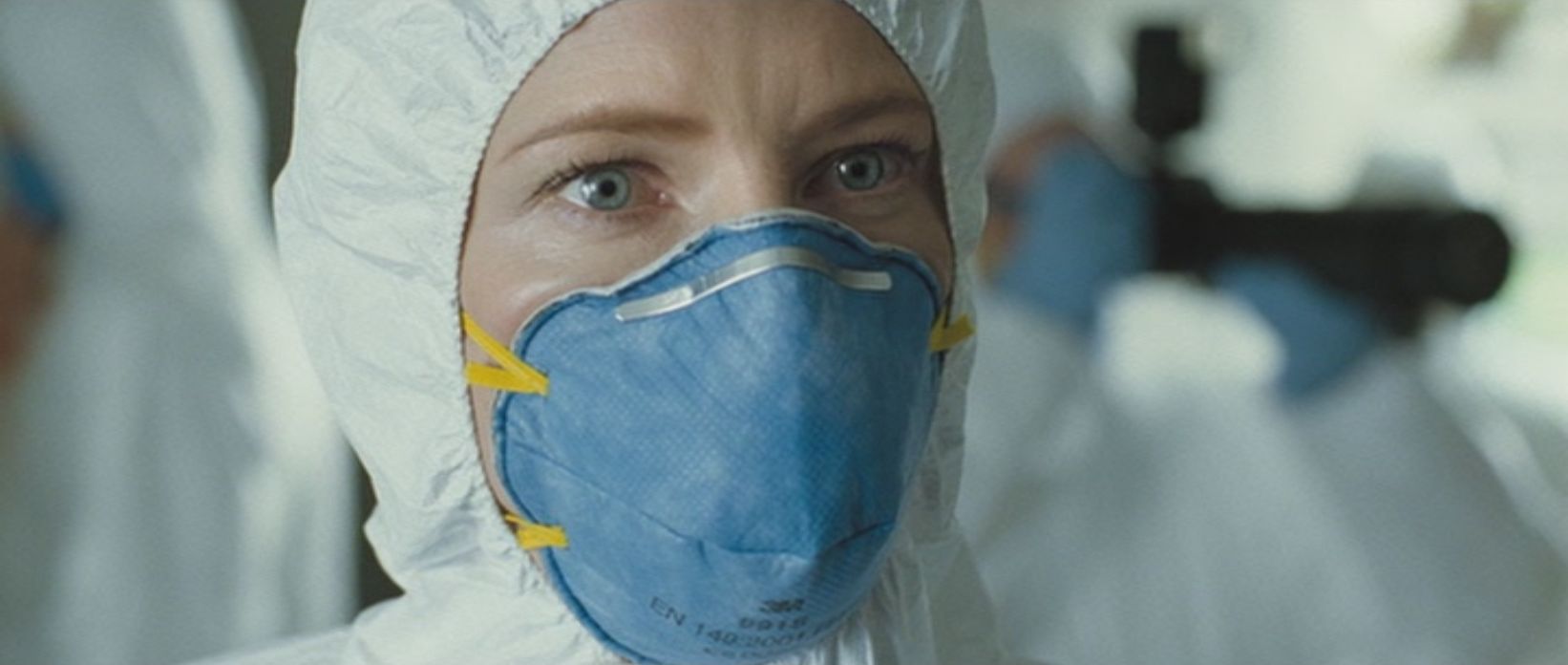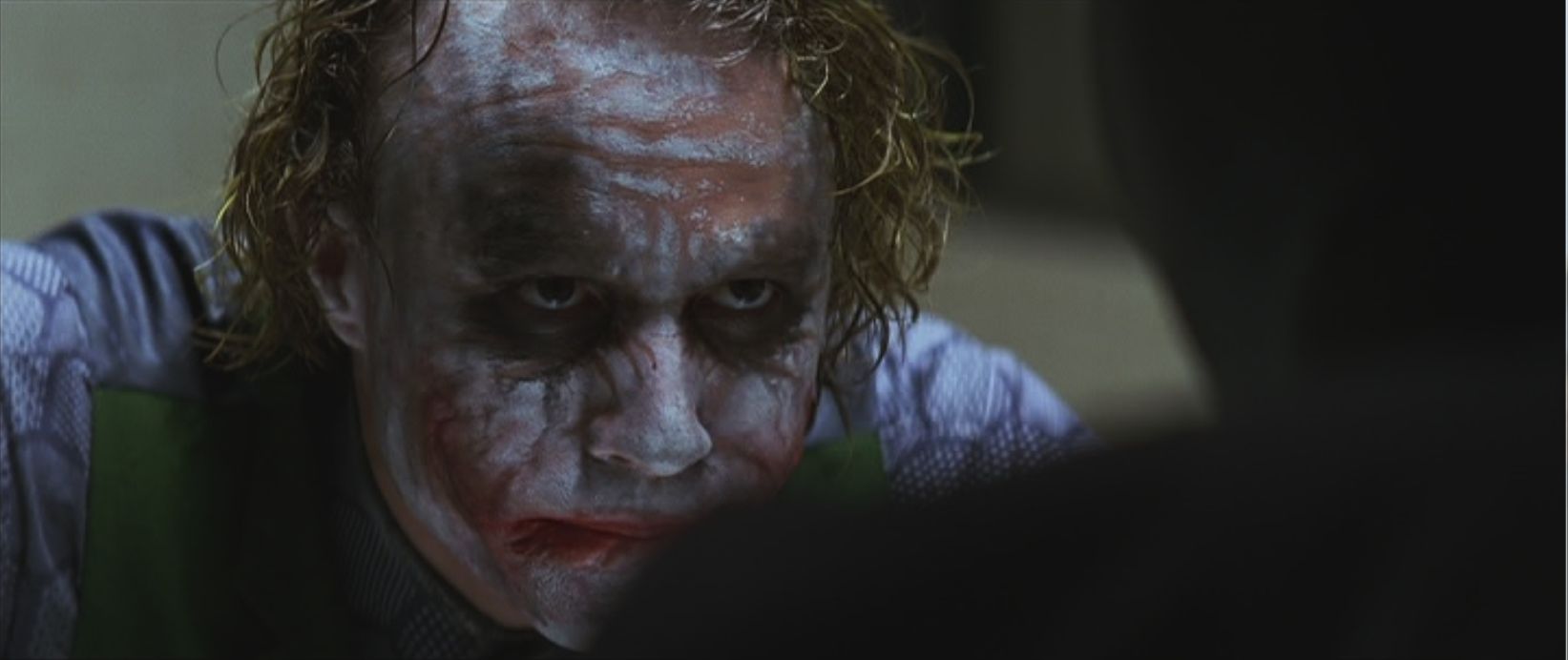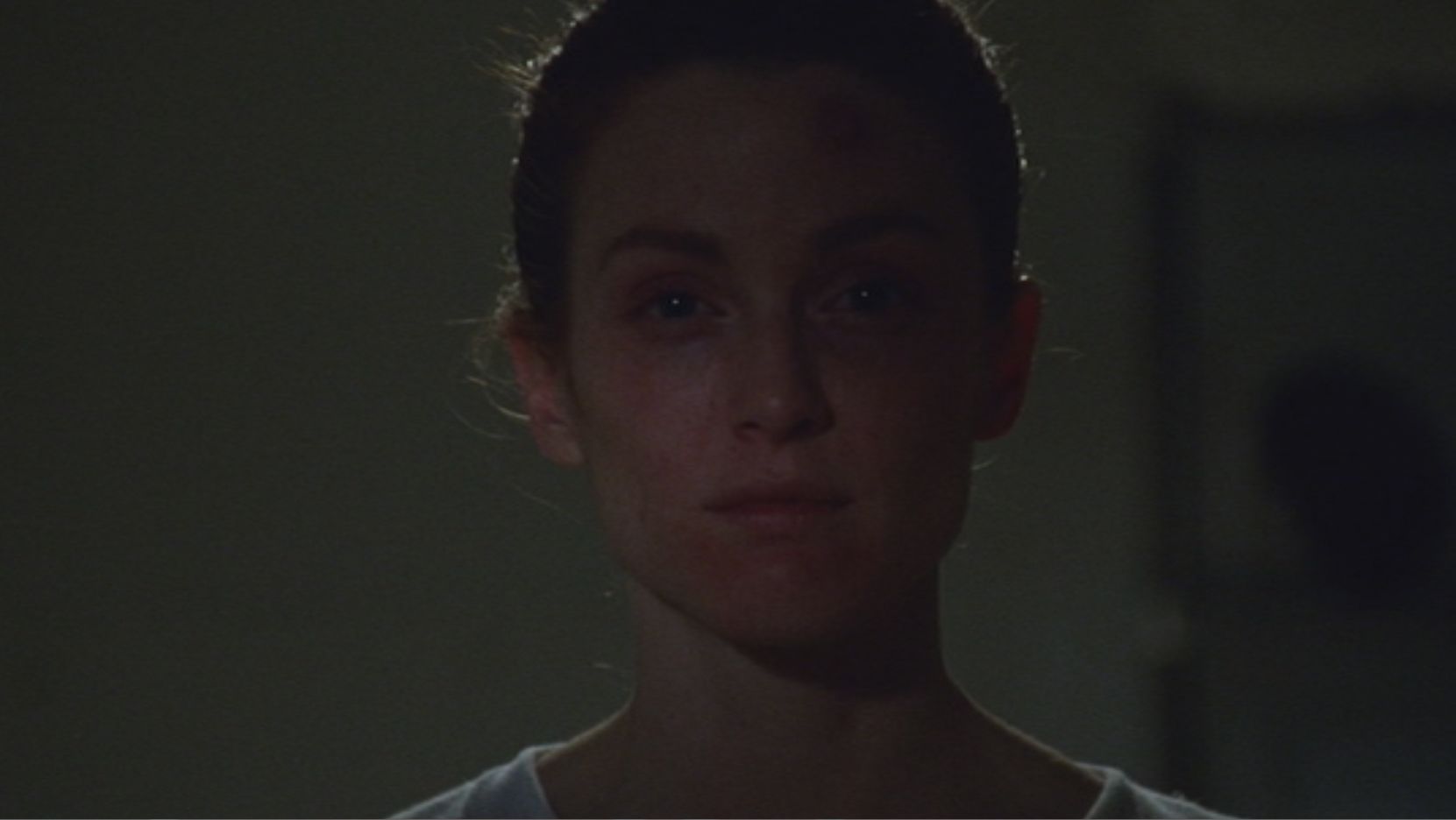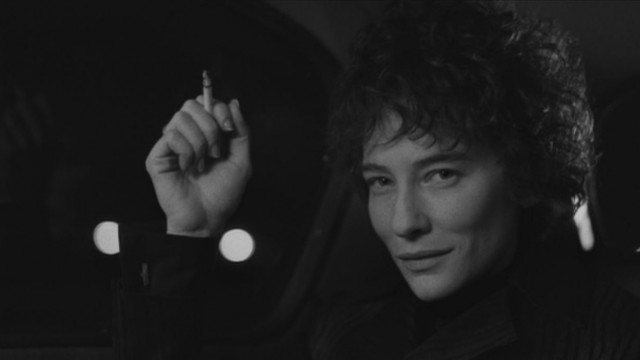The formal climax of Todd Haynes’ I’m Not There consists of a long monologue by Jude Quinn (Cate Blanchett), delivered from the back of a limousine. In the collection of Bob Dylan personae that Haynes found or created for the film, Quinn is Dylan gone electric, the one who outraged the Newport Folk Festival, subjected to endless interpretations and interrogation by fans and critics and always ready to come back with further confusion. We come into the scene from a shot of the motorcycle accident that killed this persona and started the film with an autopsy. In the limo, with the black-and-white lighting and cigarette of a noir heroine, scored with the aching harmonica solo from “Sad-Eyed Lady of the Lowlands,” Blanchett largely speaks Dylan’s own words (in an effective version rather than an imitation of Dylan’s nasal drawl) about the meaning of folk music, warning us that’s it’s not really about meaning at all:
What I’m talking about is traditional music, which is to say it’s mathematical music, it’s based on hexagons. But all these songs about, you know, roses growing out of people’s brains and lovers who are really geese and swans turning into angels–I mean, you know, they’re not going to die. They’re not folk-music songs, they’re political songs. They’re already dead.
You’d think that traditional-music people would, would gather that–mystery, you know, is a traditional fact, seeing as they’re so full of mystery. (And contradictions.) Yeah, contradictions. (And chaos.) Yes, it’s chaos, clocks, and watermelons–you know, it’s everything.
These people actually think I have some kind of–fantastic imagination. It gets very, uh, lonesome. But traditional music, it’s too unreal to die. It doesn’t need to be protected. You know, I mean, in that music, is the only true, valid death you can feel today, you know, off a record player. But like everything else in great demand, people try to own it. Has to do with the, like, the purity thing. I think its meaninglessness is holy.
Everyone knows I’m not a folk singer.
Throughout I’m Not There, Haynes commands a range of filmmaking styles and references. The touchstone of the Quinn sequences is D. A. Pennebaker’s Dylan documentary Don’t Look Back, covering Dylan’s post-Newport tour of England. Haynes captures well the sense of isolation and provocation of Dylan in that period, and Blanchett is a marvel as Quinn, always guarded but never sure what’s being guarded. Quinn knows something is going on but actually might not know what it is, and there’s fear there. In the limo, the words come out quickly, in that way where the speaker tries to find the meaning of each sentence before she gets to the end of it, and succeeds half the time. Blanchett characterizes by speech pattern, taking someone else’s words and finding a particular cadence of uncertainty, of seeking, one more way in which I’m Not There destabilizes us from anything definite. Blanchett and Haynes live up to the mystery Dylan found in traditional music.
Haynes exits the scene with the portraits of each actor playing Dylan, scored with gunshots; we saw this near the beginning. He cuts from that into Billy the Kid (Richard Gere) waking up and taking Woody Guthrie’s (Marcus Carl Franklin) guitar, riding the train, heading “back to the world” in Greil Marcus’ phrase. Just before Haynes starts firing at us and cuts into the portraits, the most mysterious moment of this sequence and really the whole film happens, as Blanchett relaxes the muscles of her face and looks at the camera.
Acting is wearing a mask, and in some traditions of theater, that’s literal. Film remains the most merciless medium at catching face and body language, and our best actors know that, building their performance not off language but off physical characteristics. Anthony Hopkins once said that he began to understand his characters by figuring out how they walked; Samuel L. Jackson keeps his head shaved so that he can have the right hair for each performance. (This is another essay unto itself.) The moments where actors can change from one person or one persona to another with nothing but a change in expression (Meryl Streep and Jeremy Irons in The French Lieutenant’s Woman, Haley Joel Osment in A. I., and the all-time champion, Viggo Mortensen in A History of Violence) will never stop stunning me out of my socks.
Acting is wearing a mask; so is being Bob Dylan. Haynes, a master of surfaces and meanings, built I’m Not There around a central insight: to not look behind the many masks of Dylan, but to accept each one for what it was. A lot of Dylan’s life was about wearing the mask, or getting unmasked, and Haynes plays with that: the discovery that a black kid calling himself “Woody Guthrie” was a middle-class Jew from northern Minnesota; Richard Gere’s Billy the Kid in hiding in the town of Riddle as Dylan hid out in a basement in upstate New York with the Band. Blanchett masks herself as Jude Quinn, whose own mask is confusion and arrogance; the fear is always there in these scenes, because maybe there’s nothing behind that mask at all. What makes that final moment in the limo so shocking is that Blanchett drops both her masks at once. Blanchett’s performance is so good that she can make us forget, until that moment, we’re seeing Cate Blanchett; I can’t even pin down Jude Quinn’s gender. She came to my (and I suspect most other viewers’) attention in Elizabeth, and since then she’s been one of the most unmistakable actresses around; those piercing eyes and high cheekbones see to that. Cover up half her face (as Edgar Wright did for one of the best jokes in Hot Fuzz) and nope, that’s still Cate Blanchett. She achieves what Heath Ledger (another mask of Dylan in I’m Not There) did in The Dark Knight, but without makeup, and like Ledger, her most powerful moment comes when the mask comes off. Ledger’s Joker is all mask, too (the first thing we see him do is put on a mask) and his strongest act is to tell Batman “don’t talk like you’re one of them. You’re not! Even if you’d like to be.” The Joker’s telling Batman to drop his mask—not the one he wears but the one he lives—and for once in the film, he sounds spontaneous, genuinely angry that Batman doesn’t get it; it’s the only time I could see Heath Ledger underneath the makeup, a double revelation like I’m Not There.
Blanchett’s performance is so good that she can make us forget, until that moment, we’re seeing Cate Blanchett; I can’t even pin down Jude Quinn’s gender. She came to my (and I suspect most other viewers’) attention in Elizabeth, and since then she’s been one of the most unmistakable actresses around; those piercing eyes and high cheekbones see to that. Cover up half her face (as Edgar Wright did for one of the best jokes in Hot Fuzz) and nope, that’s still Cate Blanchett. She achieves what Heath Ledger (another mask of Dylan in I’m Not There) did in The Dark Knight, but without makeup, and like Ledger, her most powerful moment comes when the mask comes off. Ledger’s Joker is all mask, too (the first thing we see him do is put on a mask) and his strongest act is to tell Batman “don’t talk like you’re one of them. You’re not! Even if you’d like to be.” The Joker’s telling Batman to drop his mask—not the one he wears but the one he lives—and for once in the film, he sounds spontaneous, genuinely angry that Batman doesn’t get it; it’s the only time I could see Heath Ledger underneath the makeup, a double revelation like I’m Not There. Looking at the camera, Blanchett doesn’t so much break the fourth wall as reach across it. It’s always an unnerving act, to have someone look in our eyes; there’s a reason it’s considered aggressive. Breaking the fourth wall doesn’t so much violate the reality of the movie, but our reality. It places us in the reality of the fiction we’re seeing, and what does that say about the reality we’re in for the rest of the day? That questioning, that destabilizing, that sudden feeling when a collection of light rays looks into our soul is indelible. I can’t forget it when it happens, and I can’t forget what it felt like.
Looking at the camera, Blanchett doesn’t so much break the fourth wall as reach across it. It’s always an unnerving act, to have someone look in our eyes; there’s a reason it’s considered aggressive. Breaking the fourth wall doesn’t so much violate the reality of the movie, but our reality. It places us in the reality of the fiction we’re seeing, and what does that say about the reality we’re in for the rest of the day? That questioning, that destabilizing, that sudden feeling when a collection of light rays looks into our soul is indelible. I can’t forget it when it happens, and I can’t forget what it felt like.
Haynes, that magnificent bastard, has done this kind of thing before. Even in this scene, we get two cuts to Bruce Greenwood (as good a performer as anyone in I’m Not There, playing a kind of floating superego) in a different space, looking right at Jude, and right at us. Even more powerfully and disconcertingly, his masterwork Safe ends with Julianne Moore’s Carol White at least as unmasked as Jude Quinn, looking at her reflection, looking at us, saying over and over
I love you.
I love you.
the true final girl of a true horror movie, the last shred of her Being that got progressively shredded by an enemy that couldn’t even do her the fucking courtesy of definitively existing, much less being seen. To me anyway (like the best Haynes, there are many ways this could be read), this moment has her at the most fragile, but because she’s looking right at us, she’s also undeniably strong. She found the one part of herself that can’t be defeated, like a much more overt moment in Buffy’s season-two finale “Becoming.” Safe is all about her illness, and her recovery will begin after the cut to black. Starting with Superstar: the Karen Carpenter Story, which presented said story as a puppet show, Haynes has always used masks, always liked distancing us from what’s really going on. He’d do much the same kind of double-masking in Velvet Goldmine, transposing the persona of David Bowie into Jonathan Rhys-Meyers’ Brian Slade (and fragments of Iggy Pop and Lou Reed into Ewan McGregor’s Curt Wild), adding another layer of fiction to stars who were already all about inventing themselves as fictional characters. In his theatrical films before and after I’m Not There—Far from Heaven and Carol—he’s moved the masks into the lives of his characters themselves, directly telling the story of people who have to live their lives by indirection and misdirection. (This made him, in Carol, the perfect adapter of Patricia Highsmith, which means he’d damn well better do a Ripley novel next.) One aspect of queer cinema has driven his entire career: the idea and practice of passing, of the mask, of living so much by not presenting your true self that you forget what it is.
Starting with Superstar: the Karen Carpenter Story, which presented said story as a puppet show, Haynes has always used masks, always liked distancing us from what’s really going on. He’d do much the same kind of double-masking in Velvet Goldmine, transposing the persona of David Bowie into Jonathan Rhys-Meyers’ Brian Slade (and fragments of Iggy Pop and Lou Reed into Ewan McGregor’s Curt Wild), adding another layer of fiction to stars who were already all about inventing themselves as fictional characters. In his theatrical films before and after I’m Not There—Far from Heaven and Carol—he’s moved the masks into the lives of his characters themselves, directly telling the story of people who have to live their lives by indirection and misdirection. (This made him, in Carol, the perfect adapter of Patricia Highsmith, which means he’d damn well better do a Ripley novel next.) One aspect of queer cinema has driven his entire career: the idea and practice of passing, of the mask, of living so much by not presenting your true self that you forget what it is.
I’m Not There is an unavoidably and unapologetically referential film: to fully get it, you should have a collection of Dylan songs, a biography, a copy of Marcus’ The Old, Weird America/Invisible Republic (for further discussion of masks and the Richard Gere sections), a copy of David Hajdu’s Positively 4th Street (for details on Joan and Mimi Baez and Dylan, which gets played out in some of the Christian Bale sections), and Don’t Look Back at hand. None of those matter in this scene and especially its final moment, because all of these things fall away. All the masks, all the history, all the Dylans, all of Haynes’ considerable and admirable skill and intellect disappear. I can explain everything else that leads up to that moment, but I can’t explain this, nor do I want to. Traditional music, sez Dylan, is “nothing but a mystery,” and so is what takes place in that instant of exchange, when we look at each other, when we see the expression on the face. Of course it’s an illusion; so what? That’s what cinema is, the illusion that makes us care. At the end of I’m Not There, Cate Blanchett looks at us and smiles. Nothing else matters.

